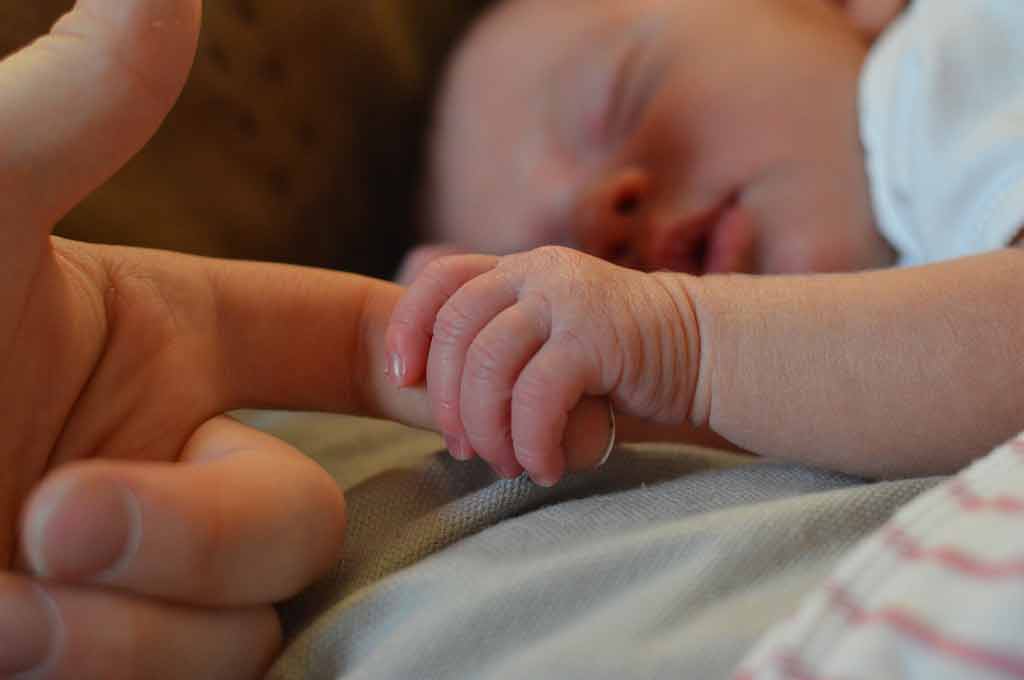Skin-to-skin contact eases babies’ pain

News article about a study investigating the effect of skin-to-skin contact (kangaroo mother care) on premature babies undergoing painful procedures
A mother’s cuddle can ease a baby’s pain, reports The Daily Telegraph today. A study has shown that a simple cuddle may even act as a natural painkiller, as “premature newborns suffered less if they experienced skin-to-skin contact with their mother as they underwent a painful medical procedure”. The lead researcher is quoted in the newspaper as saying that cuddling a newborn during such a procedure “can facilitate not only [less pain] but also a quicker recovery”.
It’s a recognised, and not unexpected, fact that young babies and children seem to suffer less distress during invasive medical procedures or examinations when they are held by their parent. This small trial has further explored whether this extends to very premature babies, and has found some evidence that it does. Holding the baby against the skin may not be appropriate in all situations, considering the special care circumstances for very premature babies. However, all of the babies in this study were in a stable medical condition. Although there may be some limitations to this study, there can be no harm in suggesting that, where possible, a mother holds her newborn infant close to her while he/she is having a potentially uncomfortable or painful procedure or examination.
Where did the story come from?
Celeste Johnston and colleagues of School of Nursing, McGill University, Montreal, and various other academic institutions across Canada, carried out this research. The study was funded by Canadian Institutes of Health Research and Fonds de la Recherche en Santé de Québec. It was published in BMC Pediatrics , a peer-reviewed medical journal.
What kind of scientific study was this?
This was a randomised crossover trial in which researchers investigated whether kangaroo mother care (KMC), where a baby is held in close skin-to-skin contact, would be beneficial for very premature babies undergoing painful procedures.
The researchers recruited mothers and babies from three hospitals in Canada. The 61 babies included in the trial were all born between 28 and 32 weeks of pregnancy, were within 10 days of birth, were able to breathe by themselves, had not received painkilling or sedative medications within 48 hours, had no major congenital abnormalities or any other serious medical condition associated with prematurity, and had not undergone surgery. All of the babies were selected on the basis that they would need to have blood taken using a heel prick on two occasions, within four days of each other. Their mothers consented to taking part in two different test situations – holding the baby during blood taking or allowing the baby to have blood taken while in an incubator.
The order in which the test situations were carried out was determined randomly by computer. For KMC, the baby was held, wearing only a nappy, in an upright position between the mother’s breasts, underneath a blanket and the mother’s clothing. The baby was held for 15 minutes before the heel prick blood test was taken. In the control condition, the baby was left to rest in a blanket in the incubator for 15 minutes before the heel prick blood was taken. The baby’s heart rate and blood oxygen saturations were continually monitored during the procedures. There was close video recording of the baby’s face, with little surrounding area, but no audio recording, so that mothers were able to talk to their babies during the procedure with the observers remaining blind as to whether the baby was being held or not.
The researchers tested the Premature Infant Pain Profile (PIPP), a validated scoring system which includes pain measures of heart rate (which goes up with pain), blood oxygen levels (which go down with pain) and three facial movements (brow bulge, eye squeeze and furrowing of the fold between the nose and lip). From the instant of heel prick, the babies’ reactions were observed in 30-second time blocks and a detailed score was given which considered the length of time the facial expression was held for. A higher score is taken as an indication of greater pain. All of the babies also had baseline measures taken prior to the procedures. The researchers took into account the baby’s age and other potentially confounding factors such as respiratory, neurological and metabolic parameters since birth and in the 12 hours before the procedures.
What were the results of the study?
The average age at which the babies in the study had been born was 30.5 weeks. Although there were no differences between the baseline levels of heart rate and blood oxygenation prior to the procedures, 60% of the infants in KMC were in quiet sleep compared with only 30% in the incubator. However, as the PIPP score took into account the baseline differences in behavioural state, giving the sleeping babies a slightly higher score at baseline than the awake ones, this should have balanced out any differences.
Overall, there was no difference in overall PIPP scores at 30 seconds or 60 seconds. However, at 90 seconds the KMC score was significantly less than the incubator score. When researchers looked at the individual measurements that contribute to the PIPP, they found that it took longer for the heart rate to return to baseline after the end of the procedure when the baby was in the incubator (193 seconds) compared with when the baby was in KMC (123 seconds). Facial expressions were significantly less in KMC at each of the three time points than when in the incubator, as was heart rate. Oxygen saturations were lower when in the incubator at 60 and 90 seconds only.
What interpretations did the researchers draw from these results?
The authors conclude that KMC skin-to-skin contact with the mother decreases pain response to heel prick in premature infants born between the ages of 28 and 32 weeks. However, the effect of KMC appears to be delayed, which is different from older infants where effects have been seen immediately at heel prick.
What does the NHS Knowledge Service make of this study?
The benefits of holding a newborn in close skin-to-skin contact during painful procedures have previously been demonstrated with term infants. This is one of the first studies to examine this effect in very premature babies, born prior to 32 weeks. A couple of points to note include:
- Interpreting the findings needs some consideration. It’s difficult to say whether being held made the baby experience less pain or whether it just made them calmer. The fact that PIPP scores at 30 and 60 seconds were no different seems to suggest that there was no difference in the level of pain induced by the procedure in the two situations. However, the lower scores at 90 seconds may suggest that babies calmed more quickly when being held by the mother.
- The difference in pain score itself was also small (less than two points on a 21 point scale), therefore the significance of this in terms of the baby’s experience is hard to determine.
- It’s not possible to say from the research whether it’s specifically skin-to-skin contact with the mother that is required, or whether the same effect could be achieved if the baby were held by another person, e.g. the father.
- As the authors point out, the person performing the heel prick was unblinded. Therefore, they may have been consciously or unconsciously gentler to the baby who was being held by the mother in KMC.
- These results cannot be generalised to any of the babies excluded from this study, e.g. those taking medications or with complications of prematurity, or to those undergoing any procedure other than a heel prick blood test.
- This study did not assess the levels of distress in the mother. In this study, some mothers did not want to take part because they did not feel comfortable holding their baby during a painful procedure.
Considering the special care circumstances for very premature babies, holding the baby against the skin may not be appropriate in all situations. However, there can be no harm in suggesting that, where possible, a mother holds her newborn infant close to her while he/she is having a potentially uncomfortable or painful procedure or examination. Any benefit there may be to the infant seems to be worth it.
Sir Muir Gray adds...
I hope this is already standard practice before this research; if not it should be, immediately.







 Subscribe
Subscribe Ask the doctor
Ask the doctor Rate this article
Rate this article Find products
Find products